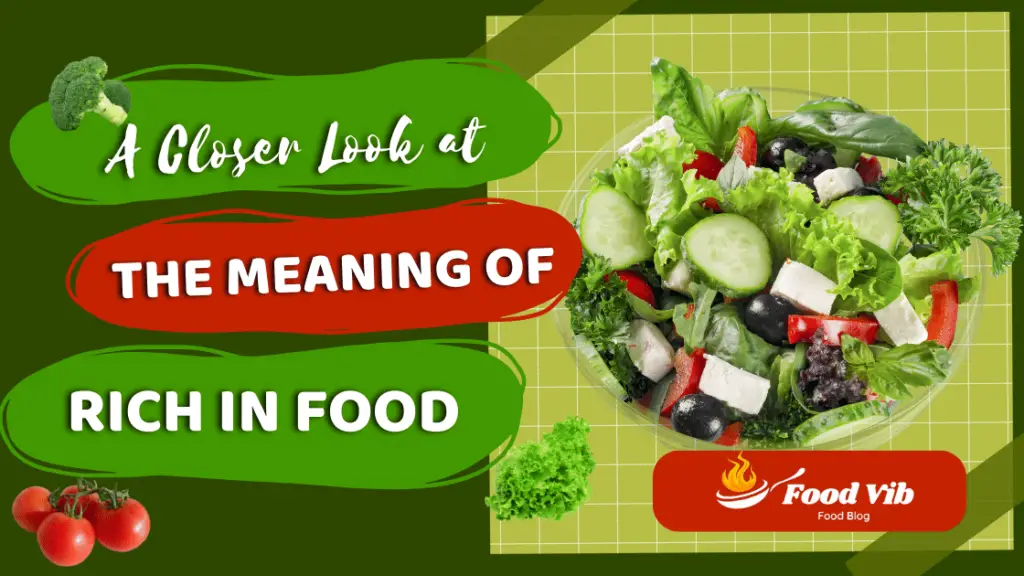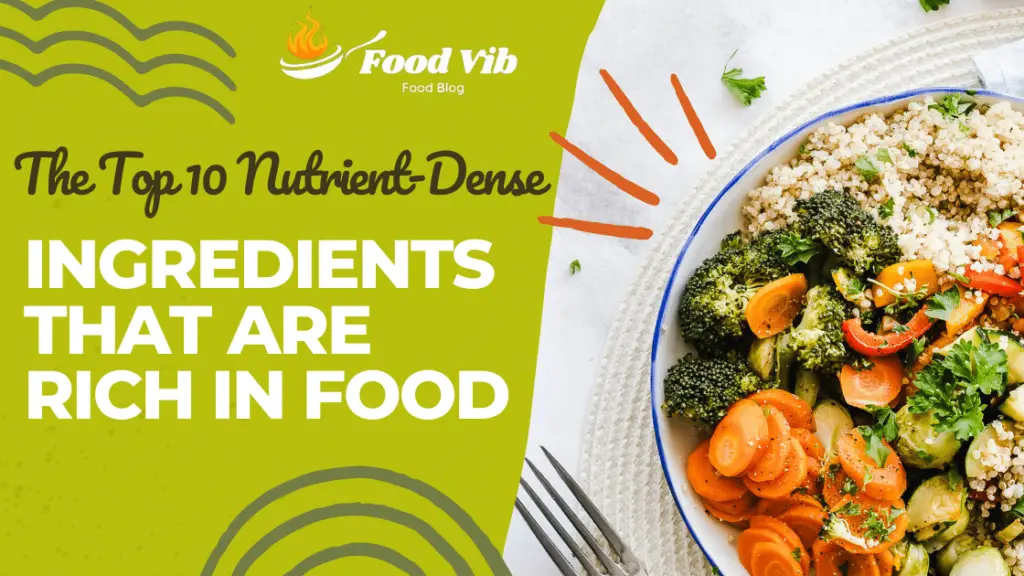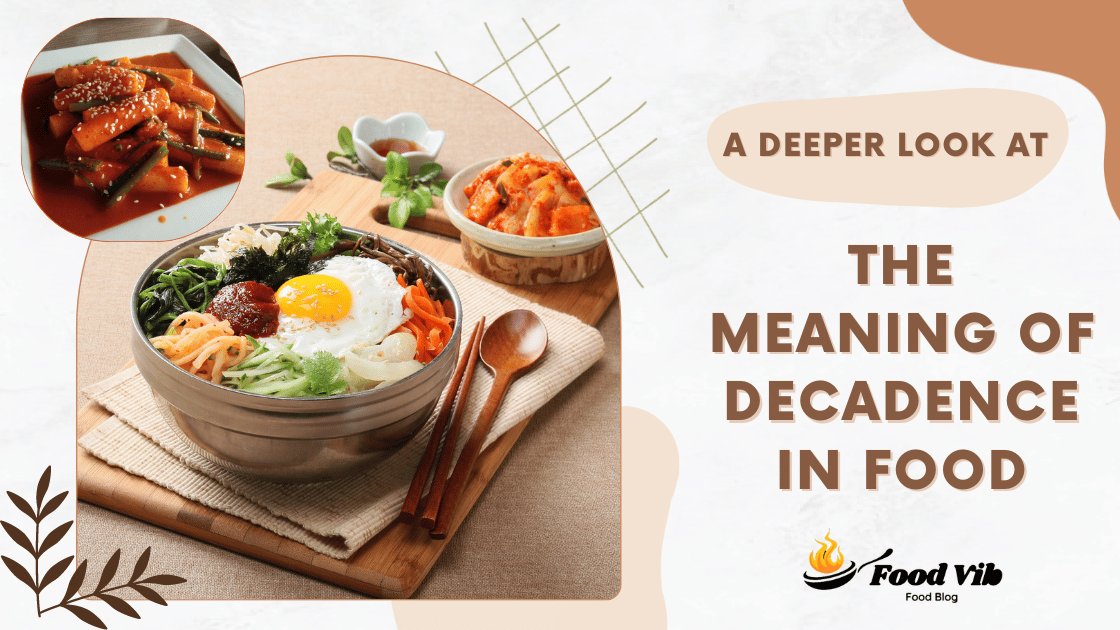A Closer Look at the Meaning of Rich in Food

When it comes to eating, “rich” means much more than just having money. Join us as we dissect and enjoy the many facets that comprise delicious food as we go on a tasting excursion. Your understanding of richness will be altered by this investigation’s palate-teasing flavors and utterly delightful textures.

A Closer Look at the Meaning of Rich in Food
Unraveling the Depths of Culinary Opulence
When it comes to food, “rich” refers to more than just financial worth; it’s a sensory experience that piques the interest of taste receptors and makes eating more enjoyable. Let’s take a culinary tour to examine the subtleties that distinguish a meal as really opulent and analyze the complex meaning of “rich” in cuisine.
The Texture Symphony
The taste of richness in food is often expressed via the well-balanced interaction of textures. Each dish generates a sensory symphony on the palate, whether it’s a silky smooth bisque, a delicious piece of marbled steak, or the richness of a flawlessly made chocolate mousse. A culinary masterpiece is defined by the harmonious blending of creaminess, softness, and crispiness.
Flavor Extravaganza
Sophisticated cuisine is characterized by an abundance of tastes. Rich flavor is a complex dance that captivates the taste receptors and leaves a lasting memory, whether it’s the umami explosion of a well-aged Parmesan, the buttery deliciousness of a lobster tail, or the sweetness that lingers in a slow-cooked caramelized onion.
Culinary Alchemy: The Art of Ingredients
We need to understand the composition of components in order to understand what “rich” really means in meals. It’s not only about the price; it’s also about carefully choosing and preparing each part. Exotic spices, truffle-infused oils, and aged cheeses are the ingredients of a culinary masterpiece, not merely things to put on a grocery list.
Must Read: Exploring the Delicious Cuisine of Pittsburgh1
The Role of Technique
Food richness is not accidental; it is the product of careful preparation. Every cooking technique, from sous-vide to slow cooking, enhances the complexity and potency of tastes. Ordinary components are transformed into spectacular delights by the chef’s mastery over his profession.
Beyond the Plate: The Ambiance Factor
The whole eating experience is more than just the food on the plate, even if the taste buds delight in the depth of tastes. The apparent richness is greatly influenced by the restaurant’s atmosphere, the dish’s presentation, and the plating skill. It’s a whole experience that goes beyond taste.
Navigating the Culinary Landscape
a.Decoding Menus: Unraveling the Language of Richness
Menus often describe foods in complex ways to highlight their richness. Knowing what is meant by phrases like “reduction,” “butter-poached,” and “truffle-infused” gives one an idea of the level of luxury one may expect. Investigating this culinary vocabulary improves the eating experience by enabling customers to make well-informed decisions that correspond with their level of richness preferences.
b.Regional Richness: A Global Tapestry
Different cultures have different ideas on what constitutes “rich” cuisine; each area has its own distinctive tastes and cooking methods. The worldwide tapestry of culinary richness, which ranges from the spice-laden richness of Indian curries to the delicate beauty of French sauces, is evidence of the variety and inventiveness inherent in human cuisine.
The Intersection of Nutrition and Indulgence
Although relishing food’s plenty is a hedonistic pleasure, it’s critical to recognize the relationship between gastronomic extravagance and dietary benefit. Today’s chefs are creating meals that satisfy the palate while also being mindful of health concerns. Modern cuisine is distinguished by its ability to strike a balance between enjoyment and thoughtful nutrition.
What Factors Contribute to Describing a Food as Rich?
When describing food’s richness, several elements come together to provide a sensory experience that goes beyond simple nourishment. Now let’s explore the subtleties that define a meal as really rich:
1.Texture Harmony
ne of the main characteristics that characterizes food richness is the interaction of textures. A symphony of creaminess, softness, and crispiness is produced on the tongue. A harmonious combination of textures in a meal that is well-balanced enhances the whole eating experience.
2.Flavor Complexity
A lavish abundance of tastes is a sign of richness in cuisine. It’s not only about flavor; it’s also about the complexity and depth of those flavors. A rich meal delivers a complex taste profile that stays and changes with time, whether it’s from the strength of the spices, the sweetness of caramelization, or the savory umami notes.
3.Quality of Ingredients
A dish’s level of richness is mostly determined by the selection and caliber of its components. Rich chocolates, aged cheeses, and premium pieces of meat are just a few examples of the high-quality ingredients that make up the base of a really extravagant meal.
4.Culinary Techniques
Using certain culinary methods is essential to creating richness. Techniques like slow-cooking, braising, and reductions bring out the flavors of common ingredients and create remarkable dishes. A rich meal may be distinguished from the ordinary by using these approaches with proficiency.
5.Innovative Combinations
Rich culinary experiences are characterized by the inventiveness with which components are combined. Chefs often push the envelope by combining unusual ingredients and creating unique taste combinations that astonish and delight the customer. Dishes that are really rich and unforgettable are distinguished by their inventiveness.
6.Aesthetic Presentation
A dish’s appearance greatly influences how wealthy people consider it to be. The eating experience is enhanced by thoughtful plating, meticulous attention to detail, and beautiful presentation. Aesthetics contribute significantly to the total richness of a culinary production rather than being an added benefit.
7.Cultural and Regional Influences
There are cultural nuances to the idea of richness in cuisine. The distinctive components that characterize each region’s and cuisine’s interpretation of culinary richness are contributed by them. Understanding other cultural viewpoints deepens one’s awareness of food’s complexity.
8.Balancing Indulgence and Nutrition
Current food trends place a strong emphasis on striking a balance between indulgence and nutrient intake. It is now possible to create rich meals that are health-conscious while yet maintaining an opulent taste by using fresh, healthful ingredients. The way that health and taste interact gives the concept of richness a more modern meaning.
The Top 10 Nutrient-Dense Ingredients That Are Rich in Food
Discovering the keys to a nutrient-dense diet entails adding foods that not only entice the palate but also provide nourishment for the body. The top 10 nutrient-dense foods that add richness to your meals and are a powerhouse of vital vitamins, minerals, and other healthy substances are listed below.

1. Quinoa
Known for being a complete protein, quinoa is a grain that has a remarkable nutritional makeup. Rich in fiber, vitamins, and minerals, it gives food a substantial richness and contributes vital amino acids that are important for general well-being.
2. Salmon
Rich in nutrients, fatty fish, particularly salmon, is a nutritional gold mine. Packed full of omega-3 fatty acids, it supports brain and heart health. Salmon’s luscious, creamy texture gives your meal an extra layer of decadence.
3. Kale
considered a superfood due to its abundance of vitamins A, C, and K, kale is a lush green vegetable. It elevates taste and nutritional value in salads, soups, and sautés because of its sturdy texture and strong flavor.
4. Avocado
Rich in nutrients and delicious, avocados are a great complement to meals. They are creamy and velvety. Avocados are rich in monounsaturated fats, which promote fullness, and they also include a variety of vitamins and minerals.
5. Sweet Potatoes
Sweet potatoes’ strong beta-carotene concentration is shown by their vivid orange color. Sweet potatoes are a great source of carbohydrates that are satisfying and tasty, but they also include a lot of vitamins and antioxidants that help strengthen the immune system.
6. Chia Seeds
Packed with nourishment, chia seeds are little but formidable. Packed with fiber, omega-3 fatty acids, and other minerals, these seeds give food a delicious crunch and support healthy digestion and general well-being.
7. Almonds
A typical example of a nut high in nutrients is the almond. Full of protein, heart-healthy monounsaturated fats, and vital vitamins and minerals, they may be added crisp texture to a variety of dishes or enjoyed as a pleasant and nourishing snack.
8. Broccoli
Packed with vitamins C and K, this cruciferous vegetable is also high in fiber. Its flexibility in the kitchen enables the production of salads, stir-fries, and side dishes that are high in nutrients.
9. Greek Yogurt
Rich in protein, Greek yogurt has a creamy texture and tangy taste. It is also high in calcium and offers probiotics to support digestive health, making it a nutritious addition to both savory and sweet recipes.
10. Berries
Packed with antioxidants, berries like raspberries, strawberries, and blueberries are naturally sweet and overflowing with flavor. These colorful fruits provide sweets, breakfast bowls, and snacks with a delightful richness while supporting the immune system and general health.
Conclusion
Including these nutrient-dense items in your cooking not only makes your dishes taste better but also encourages a balanced, health-conscious eating style. These items, which range from colorful veggies to protein-rich superfoods, are the foundation of a tasty, nutrient-rich meal.
Must Read: The Surprising Reasons Chinese Food Makes You Hungry
FAQ (Frequently Asked Question)
Can you provide examples of foods that are considered rich in nutrients?
Because they include significant amounts of vitamins, minerals, and good fats, foods like salmon, avocados, almonds, and leafy greens are often regarded as being rich in nutrients.
. How is the richness of food measured nutritionally?
Evaluating a food's nutrient profile—which includes the quantities of vitamins, minerals, proteins, and other necessary components per serving—is a typical way to determine how nutrient-rich a dish is.
What are the potential benefits of consuming food that is rich in nutrients?
Eating meals high in nutrients promotes immune system function, energy levels, and the healthy operation of many body systems. It also improves general health.
How does the richness of food contribute to a balanced diet?
Eating a range of foods high in nutrients may assist in maintaining a balance of vital nutrients in the body, preventing and supporting good health.
What is considered as 'too rich' when it comes to food?
Food is deemed "too rich" if it has an excessive quantity of calories, carbohydrates, or saturated fats, all of which when ingested in excess might cause health problems.
Are there any negative effects associated with regularly consuming food that is too rich?
Eating food that is too high in harmful ingredients on a regular basis may lead to weight gain, cardiovascular difficulties, and other health concerns.
How can one strike a balance between enjoying rich foods and maintaining a healthy diet?
Reducing portion sizes, eating in moderation, and balancing rich food intake with a range of nutrient-dense, complete foods are all part of this strategy.
Does the term “rich” in food only refer to nutritional content, or can it also encompass flavor and indulgence?
The term "rich" in cuisine may not just relate to a meal's nutritional value; it can also describe a dish's flavor and decadence, signifying a gratifying and opulent palate experience.
What is the significance of understanding the concept of “rich in food” in the context of dietary choices?
Having a comprehensive understanding of what constitutes a "rich in food" diet is essential to make well-informed dietary decisions that support personal health objectives and promote a satisfying and well-rounded eating style.





One Comment